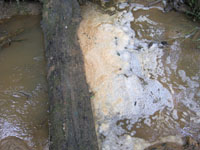 Foam, suds or bubbles in a stream may be the result of a natural process or human pollution. Foam develops in streams when certain substances interact with the water, reducing the surface tension which makes air bubbles on the water. Nature contributes to the creation of foam, suds or bubbles when plants and animals decompose and release a substance that can break down the surface tension of the water.
Foam, suds or bubbles in a stream may be the result of a natural process or human pollution. Foam develops in streams when certain substances interact with the water, reducing the surface tension which makes air bubbles on the water. Nature contributes to the creation of foam, suds or bubbles when plants and animals decompose and release a substance that can break down the surface tension of the water.
Over fertilizing your lawn can cause excess plant and algae growth to occur in local streams. The decomposition of this excess growth will lead to an increase in foam, suds and bubbles.
Car washing on hard surfaces, washing machine discharge, sanitary sewer or septic field failure and certain types of industrial discharge from paint and pesticide production can be a source of man-made foam, suds or bubbles in streams.